|
|
| |
PORTUGAL
LISBON
GEOGRAPHY, HISTORY, LANDMARKS
Capital of Portugal since its conquest from the Moors in 1147, Lisbon is a legendary city with over 20 centuries of History. The Alfama is one of the oldest quarters in Lisboa. Since it largely survived the earthquake of 1755, the area still retains much of its original layout. Adjacent to the Alfama are the likewise old quarters of Castelo and Mouraria, on the western and northern slopes of the hill that is crowned by St. George's Castle.
 Lisbon downtown
Photo Wikipedia Every year in June, the streets of all three quarters come alive with the feasts in honour of the popular saints. The Graça quarter and the churches of São Vicente de Fora and Santa Engrácia are within walking distance of this area. Radiant skies brighten the monumental city, with its typical tile covered building facades and narrow Medieval streets, where one can hear the fado being played and sung at night. But Lisbon is also the stage for popular festivities, the place for exquisite shopping, exciting nightlife, and interesting museums, a place from where motorways branch off in different directions.
Alfama district
The oldest district of the city is Alfama, close to the Tagus, which has made it relatively unscathed through the various earthquakes. The Castle of São Jorge and the Lisbon Cathedral are located in this area. Other attractions include:
Monastery of São Vicente de Fora
Church of Santo António
Santa Luzia Belvedere
Largo das Portas ao Sol
Baixa
The heart of the city is the Baixa (Downtown) or city centre; this area of the city is being considered for UNESCO World Heritage Site status. The Baixa is organised in a grid system and a network of squares built after the 1755 Lisbon earthquake, which levelled a great portion of the medieval city. Other monuments in this area include:
Praça do Comércio (Commerce Square) and Rossio Square the oldest and historically most important squares in Lisbon
Church of Nossa Senhora da Conceição Velha which has a beautiful manueline façade
Church of São Domingos
Restauradores Square
Elevador de Santa Justa, an elevator (lift) in Gothic revival style, built around 1900 to connect the Baixa and Chiado.
Camões Square
Palácio Nacional da Ajuda
Orient Station
A tram in Lisbon
Chiado
The trendiest area in the city, Chiado is home to cafes, galleries, bookshops and relevant examples of 18th century religious architecture. Attractions include:
Basilica dos Mártires
Brasileira Cafe
Carmo Convent
Church of Corpo Santo
Church of Nossa Senhora do Loreto
Museu do Chiado, which houses most important works of Portuguese contemporary art
The richly-decorated Church of São Roque is located nearby.
Bairro Alto
Bairro Alto (literally upper quarter in Portuguese) is an area of central Lisbon. It functions as a residential, shopping and entertainment district. Today, the Bairro Alto is the heart of Lisbon's youth and of the Portuguese capital's nightlife. Lisbon's Punk, Gay, Metal, Goth, Hip Hop and Reggae scenes, all have the Bairro as their home, due to the number of clubs and bars dedicated to each of them. The fado, Portugal's national song, still survives in the new Lisbon's nightlife. The crowd is a mix of local and tourist, straight and gay, and almost anything else imagined.
Estrela
The Baroque-Neoclassical Estrela Basilica is the main attraction of this district. The Parliament and the Prazeres Cemetery are nearby.
Belém
Along the Rio Tejo (Tagus River), is the historic neighborhood of Belém. Its prime attraction is the grand Jerónimos Monastery. Construction started in 1501, and took 70 years to complete. During its construction, the monastery cost an equivalent of Template:Convert/LoffAyesDbSoff of gold each year.
 Belém tower
Photo Wikipedia Most of the construction costs were financed through the spice trade. It is a prime example of what is called Manueline architecture, with inspiration brought back from the explorations, as well as being influenced by the Gothic and Renaissance periods. Other attractions within the area are:
Padrão dos Descobrimentos (Monument of the Discoveries), built in mid-20th century, during Estado Novo dictatorial regime
Belem Cultural Centre, example of Portuguese contemporary architecture, finished in 1994
Belem Tower, an ex-libris of the city, built in the 16th century
Belem Palace, 18th century palace, which is now the official residence of the President of the Republic
Coach Museum, displaying most relevant and spectuacular carriages from 17th to 19th century.
Gare do Oriente
Gare do Oriente (Orient Station) is one of the main transportation hubs of Lisbon, for trains, metro, buses and taxis. Its glass and steel columns are reminiscent of palms, making the whole structure fascinating to look at (especially in sunlight or when illuminated at night). It was designed by the architect Santiago Calatrava from Valencia (Spain). Cross through the shopping mall just across the street and you are in Parque das Nações (Park of the Nations), site of the 1998 World Expo.
Lisbon trams and funiculars
Transportation in Lisbon is more charming than in most cities. Much is owed to its geography; a part of Lisbon has been built on its seven hills. No visit to Lisbon is complete without riding the 1930s trams. The greatest attractions, though, are the funiculars, of which there are three. These are Elevador da Glória, Elevador da Bica, and Elevador da Lavra.
 Lisbon trams
Photo WikipediaPerhaps the most picturesque is the Elevador da Bica, which passes through a charming residential neighborhood just below Bairro Alto
National Art Museum (Museu Nacional de Arte Antiga)
The museum's collection includes seven finest collections of Painting, Sculpture, Drawings, Engraving, Jewelry, Ceramic, Textile and Furniture from the 12th to the 19th Centuries. It exhibits the masterpieces of European, African and Oriental art.
Folk Art Museum (Museu de Arte Popular)
The Museum's collection primarily consists of regional Portuguese paintings, furniture and ceramics.
Chiado Museum - National Museum of Contemporary Art (Museu Do Chiado - Museu Nacional de Arte Contemporanea)
Located in the heart of the city, Museum gathers a remarkable collection of Portuguese art dating from 1820 up to present and holds the most significant collection of Portuguese contemporary art including Columbano and Almada Negreiros.
Gulbenkian Modern Art Center Museum (Centro de Arte Moderna-Fund. Gulbenkian)
It exhibits the 20th century art collection of the Calouste Gulbenkian Foundation.
Calouste Gulbenkian Museum (Museu Calouste Gulbenkian)
The museum presents hilarious private collection of Calouste Gulbenkian, more than 6000 pieces. It is divided into two; the first part is dedicated to Oriental and Classic art and the second part is dedicated to European Art.
National Costume Museum (Museu Nacional do Traje e da Moda)
The Museum currently exhibits over 30.000 items; costumes from different periods, including clothes from 14th to 19th centuries, accessories and toys and has a section on textile technology.
Puppet Museum (Museu da Marioneta)
It presents a wide collection of traditional puppets from all around the world in a restored 17th century convent named the Convento Das Bernardas. Even though the Museum aims to provide a general view of puppets from all around the world, it gives a special attention to Portuguese Puppet Theater. The museum fascinates the visitors through a great range of masks coming from all over the world and shadows. Special collections includes: Dolls (Japanese), Masks (Oriental), Puppets (Oriental), Puppets (Portuguese), Stage machinery, reconstructions (Baroque), Teatro Branca-Flor, Teatro do Mestre Gil, Teatro Robertoscope M.S. Lourenço.
National Museum of Archaeology (Museu Nacional de Arqueologia)
A part of Jerónimo Monastry since 1903, this museum holds a magnificent collection of Portuguese archeological finds and objects from the prehistoric era to the medieval and Moslem eras including fascinating jewelry collections and items from Egyptian art.
| |
|
Festivals & Events
Festa do São Pedro
Sintra
Every 2nd & 4th Sunday of the month. A fair of antiques and handicrafts in the hill resort-village, north of Lisbon.
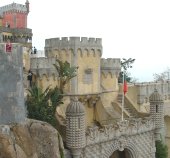
Pena National Palace
Flea Market
Lisbon
The flea market runs every Tuesday and Saturday from sunrise to 12 noon. This is where you will find all you could want. Lisbon’s "Feira da Ladra" reminds foreigners of Paris’s flea market and attracts crowds looking for that second-hand and new item bargains.
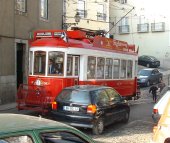
Lisbon
Gulbenkian Foundation
Lisbon
Several annual events are made by this Foundation throughout the year (ACARTE Festival; Great World Orchestras cycle; Antique Music cycle; Ballet; Festival of contemporary music) including series of concerts with some of the world’s most prominent chamber orchestras, dance groups, contemporary music, classical concerts performed by the most prestigious guest soloists.
musica@gulbenkian.pt
Carnival
9 - 12 February
Carnival festivities throughout all of Portugal with spectacular and colorful parades of costume, namely in Lisbon, Loulé, Nazaré, Torres Vedras, Ovar, Mealhada, Viana do Castelo, Sines, Alcobaça and Funchal.
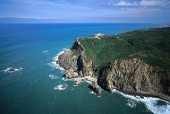 Cabo da Roca
Fantásporto do Porto
Porto - February
International cinema festival. Currently considered one of the most important festivals of cinema in the world. Fantasporto began in 1981 as "Mostra de Cinema Fantástico", turning into the most progessive and talked about cultural event in cimena and theater in Portugal.
Holy Week Festivities
(Festividades da Semana Santa), March
To the north, particularly noteworthy in Braga (a citadel of Christianity when most of Portugal was Moorish and still the ecclesiastical capital) and in Ovar and Póvoa de Varzim. The most important events take place on Holy Thursday and Good Friday when the imposing parades pass through the streets.
Flower Festival
Funchal, Madeira - April
On the 13th, the traditional wall of hope festivities and the 14th is the breathtaking grand parade of Madeira’s capital with thousands of different types of flowers leaving behind the perfumed scent on the streets they pass.
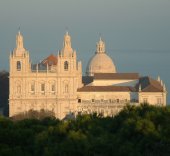 Lisbon
Bullfight Season
Lisbon - May
The season runs through September with fights every Thursday evening and Sunday afternoons in the Campo Pequeno bullring. In Portugal, the bulls are tackled and wrestled to a standstill, but not killed in the arena.
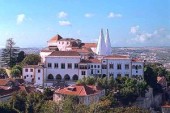 Sintra Palace
Pilgrimage to Fátima
Fátima - May
Fátima is about 100 km north of Lisbon. The Fátima Sanctuary is a pilgrimage site for millions of Catholics from around the world and a place of devotion for most Portuguese people. This sanctuary is one of the most important Marian sites, as Lourdes in France and Chestochowa in Poland. On the 12th there is a candlelight procession and on the 13th is the most important day when devotees and pilgrims from around the world congregate at the sanctuary to mark the anniversary of the first apparition of the Virgin Mary to the shepards in 1917.
rtleiria.fatima@mail.telepac.pt
Portugal’s National Day and Camões Day, 10 June
Held throughout all of Portugal. This day celebrates Portugal’s independence, as well as, its epic poet, Luís Vaz de Camões, who told the story of the nautical discoveries in ‘Os Lusíadas’ in 1572. This day has emphasis on cultural events with traditional celebrations.
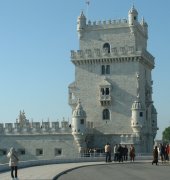 Tower of Belem
Sintra Music Festival, June - July
One of Portugal’s most prestigious summer festivals of serious music. The World Heritage Village of Sintra (about 20 minutes from Lisbon) hosts a stage for a series of concerts and recitals by major orchestras, ensembles and performers from Portugal and abroad. Leading musicians perform at the Royal Palace in Sintra and Queluz and also includes Ballet nights in Seteais.
Red Waistcoast Festival
(Festas do Colete Encarnado)
Vila Franca de Xira - July
This feast was named after the traditional costumes of the ‘Ribatejo’ horsemen. This fair includes the running of the bulls through the streets, regional folk dances competitions of the ‘campinos’ (cowboys), and bullfights. The highlight is Saturday night when the town parties until daybreak.
National Gastronomy Festival
Santarém - October
One of the biggest gastronomical festival featuring traditional and regional foods of the entire country accompanied by Portuguese wines. Feast on the best cuisine while enjoying the traditional folklore music that Portugal has got to offer.
|